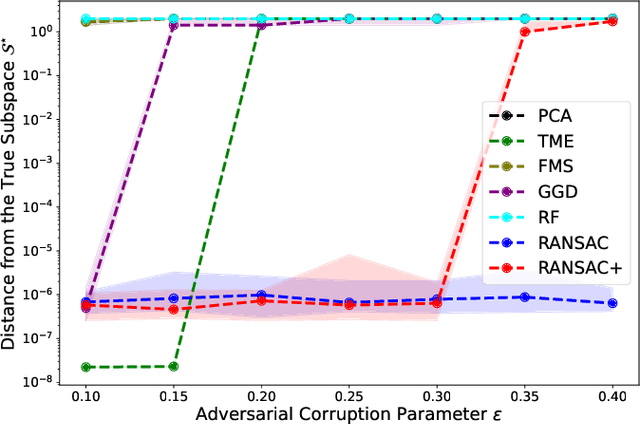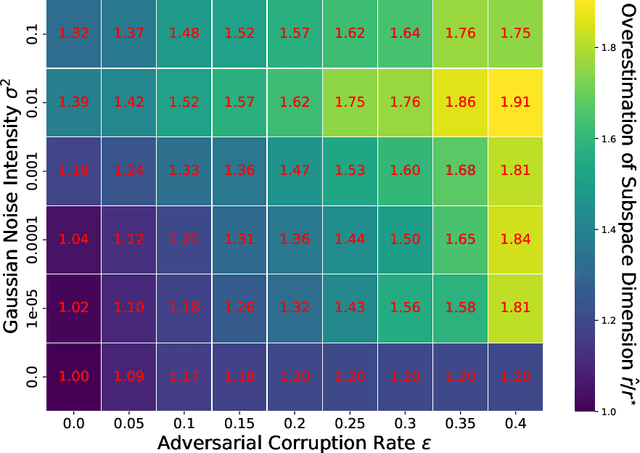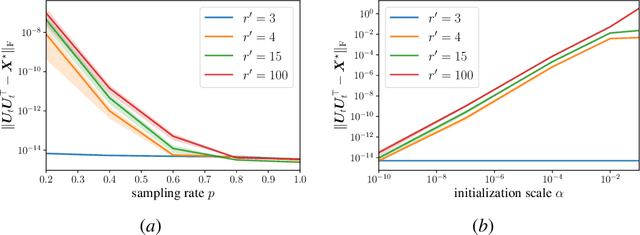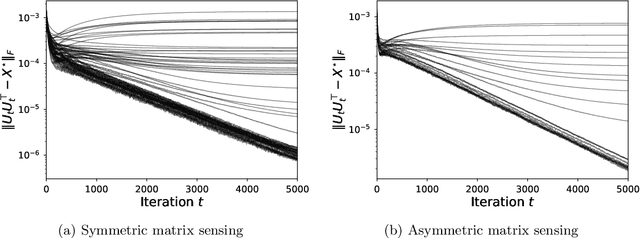Jianhao Ma
Implicit Regularization of Infinitesimally-perturbed Gradient Descent Toward Low-dimensional Solutions
May 22, 2025Abstract:Implicit regularization refers to the phenomenon where local search algorithms converge to low-dimensional solutions, even when such structures are neither explicitly specified nor encoded in the optimization problem. While widely observed, this phenomenon remains theoretically underexplored, particularly in modern over-parameterized problems. In this paper, we study the conditions that enable implicit regularization by investigating when gradient-based methods converge to second-order stationary points (SOSPs) within an implicit low-dimensional region of a smooth, possibly nonconvex function. We show that successful implicit regularization hinges on two key conditions: $(i)$ the ability to efficiently escape strict saddle points, while $(ii)$ maintaining proximity to the implicit region. Existing analyses enabling the convergence of gradient descent (GD) to SOSPs often rely on injecting large perturbations to escape strict saddle points. However, this comes at the cost of deviating from the implicit region. The central premise of this paper is that it is possible to achieve the best of both worlds: efficiently escaping strict saddle points using infinitesimal perturbations, while controlling deviation from the implicit region via a small deviation rate. We show that infinitesimally perturbed gradient descent (IPGD), which can be interpreted as GD with inherent ``round-off errors'', can provably satisfy both conditions. We apply our framework to the problem of over-parameterized matrix sensing, where we establish formal guarantees for the implicit regularization behavior of IPGD. We further demonstrate through extensive experiments that these insights extend to a broader class of learning problems.
RANSAC Revisited: An Improved Algorithm for Robust Subspace Recovery under Adversarial and Noisy Corruptions
Apr 13, 2025


Abstract:In this paper, we study the problem of robust subspace recovery (RSR) in the presence of both strong adversarial corruptions and Gaussian noise. Specifically, given a limited number of noisy samples -- some of which are tampered by an adaptive and strong adversary -- we aim to recover a low-dimensional subspace that approximately contains a significant fraction of the uncorrupted samples, up to an error that scales with the Gaussian noise. Existing approaches to this problem often suffer from high computational costs or rely on restrictive distributional assumptions, limiting their applicability in truly adversarial settings. To address these challenges, we revisit the classical random sample consensus (RANSAC) algorithm, which offers strong robustness to adversarial outliers, but sacrifices efficiency and robustness against Gaussian noise and model misspecification in the process. We propose a two-stage algorithm, RANSAC+, that precisely pinpoints and remedies the failure modes of standard RANSAC. Our method is provably robust to both Gaussian and adversarial corruptions, achieves near-optimal sample complexity without requiring prior knowledge of the subspace dimension, and is more efficient than existing RANSAC-type methods.
PARQ: Piecewise-Affine Regularized Quantization
Mar 19, 2025Abstract:We develop a principled method for quantization-aware training (QAT) of large-scale machine learning models. Specifically, we show that convex, piecewise-affine regularization (PAR) can effectively induce the model parameters to cluster towards discrete values. We minimize PAR-regularized loss functions using an aggregate proximal stochastic gradient method (AProx) and prove that it has last-iterate convergence. Our approach provides an interpretation of the straight-through estimator (STE), a widely used heuristic for QAT, as the asymptotic form of PARQ. We conduct experiments to demonstrate that PARQ obtains competitive performance on convolution- and transformer-based vision tasks.
Convergence of Gradient Descent with Small Initialization for Unregularized Matrix Completion
Feb 09, 2024

Abstract:We study the problem of symmetric matrix completion, where the goal is to reconstruct a positive semidefinite matrix $\rm{X}^\star \in \mathbb{R}^{d\times d}$ of rank-$r$, parameterized by $\rm{U}\rm{U}^{\top}$, from only a subset of its observed entries. We show that the vanilla gradient descent (GD) with small initialization provably converges to the ground truth $\rm{X}^\star$ without requiring any explicit regularization. This convergence result holds true even in the over-parameterized scenario, where the true rank $r$ is unknown and conservatively over-estimated by a search rank $r'\gg r$. The existing results for this problem either require explicit regularization, a sufficiently accurate initial point, or exact knowledge of the true rank $r$. In the over-parameterized regime where $r'\geq r$, we show that, with $\widetilde\Omega(dr^9)$ observations, GD with an initial point $\|\rm{U}_0\| \leq \epsilon$ converges near-linearly to an $\epsilon$-neighborhood of $\rm{X}^\star$. Consequently, smaller initial points result in increasingly accurate solutions. Surprisingly, neither the convergence rate nor the final accuracy depends on the over-parameterized search rank $r'$, and they are only governed by the true rank $r$. In the exactly-parameterized regime where $r'=r$, we further enhance this result by proving that GD converges at a faster rate to achieve an arbitrarily small accuracy $\epsilon>0$, provided the initial point satisfies $\|\rm{U}_0\| = O(1/d)$. At the crux of our method lies a novel weakly-coupled leave-one-out analysis, which allows us to establish the global convergence of GD, extending beyond what was previously possible using the classical leave-one-out analysis.
Robust Sparse Mean Estimation via Incremental Learning
May 24, 2023Abstract:In this paper, we study the problem of robust sparse mean estimation, where the goal is to estimate a $k$-sparse mean from a collection of partially corrupted samples drawn from a heavy-tailed distribution. Existing estimators face two critical challenges in this setting. First, they are limited by a conjectured computational-statistical tradeoff, implying that any computationally efficient algorithm needs $\tilde\Omega(k^2)$ samples, while its statistically-optimal counterpart only requires $\tilde O(k)$ samples. Second, the existing estimators fall short of practical use as they scale poorly with the ambient dimension. This paper presents a simple mean estimator that overcomes both challenges under moderate conditions: it runs in near-linear time and memory (both with respect to the ambient dimension) while requiring only $\tilde O(k)$ samples to recover the true mean. At the core of our method lies an incremental learning phenomenon: we introduce a simple nonconvex framework that can incrementally learn the top-$k$ nonzero elements of the mean while keeping the zero elements arbitrarily small. Unlike existing estimators, our method does not need any prior knowledge of the sparsity level $k$. We prove the optimality of our estimator by providing a matching information-theoretic lower bound. Finally, we conduct a series of simulations to corroborate our theoretical findings. Our code is available at https://github.com/huihui0902/Robust_mean_estimation.
On the Optimization Landscape of Burer-Monteiro Factorization: When do Global Solutions Correspond to Ground Truth?
Feb 21, 2023

Abstract:In low-rank matrix recovery, the goal is to recover a low-rank matrix, given a limited number of linear and possibly noisy measurements. Low-rank matrix recovery is typically solved via a nonconvex method called Burer-Monteiro factorization (BM). If the rank of the ground truth is known, BM is free of sub-optimal local solutions, and its true solutions coincide with the global solutions -- that is, the true solutions are identifiable. When the rank of the ground truth is unknown, it must be over-estimated, giving rise to an over-parameterized BM. In the noiseless regime, it is recently shown that over-estimation of the rank leads to progressively fewer sub-optimal local solutions while preserving the identifiability of the true solutions. In this work, we show that with noisy measurements, the global solutions of the over-parameterized BM no longer correspond to the true solutions, essentially transmuting over-parameterization from blessing to curse. In particular, we study two classes of low-rank matrix recovery, namely matrix completion and matrix sensing. For matrix completion, we show that even if the rank is only slightly over-estimated and with very mild assumptions on the noise, none of the true solutions are local or global solutions. For matrix sensing, we show that to guarantee the correspondence between global and true solutions, it is necessary and sufficient for the number of samples to scale linearly with the over-estimated rank, which can be drastically larger than its optimal sample complexity that only scales with the true rank.
Behind the Scenes of Gradient Descent: A Trajectory Analysis via Basis Function Decomposition
Oct 04, 2022



Abstract:This work analyzes the solution trajectory of gradient-based algorithms via a novel basis function decomposition. We show that, although solution trajectories of gradient-based algorithms may vary depending on the learning task, they behave almost monotonically when projected onto an appropriate orthonormal function basis. Such projection gives rise to a basis function decomposition of the solution trajectory. Theoretically, we use our proposed basis function decomposition to establish the convergence of gradient descent (GD) on several representative learning tasks. In particular, we improve the convergence of GD on symmetric matrix factorization and provide a completely new convergence result for the orthogonal symmetric tensor decomposition. Empirically, we illustrate the promise of our proposed framework on realistic deep neural networks (DNNs) across different architectures, gradient-based solvers, and datasets. Our key finding is that gradient-based algorithms monotonically learn the coefficients of a particular orthonormal function basis of DNNs defined as the eigenvectors of the conjugate kernel after training. Our code is available at https://github.com/jianhaoma/function-basis-decomposition.
Blessing of Nonconvexity in Deep Linear Models: Depth Flattens the Optimization Landscape Around the True Solution
Jul 15, 2022



Abstract:This work characterizes the effect of depth on the optimization landscape of linear regression, showing that, despite their nonconvexity, deeper models have more desirable optimization landscape. We consider a robust and over-parameterized setting, where a subset of measurements are grossly corrupted with noise and the true linear model is captured via an $N$-layer linear neural network. On the negative side, we show that this problem \textit{does not} have a benign landscape: given any $N\geq 1$, with constant probability, there exists a solution corresponding to the ground truth that is neither local nor global minimum. However, on the positive side, we prove that, for any $N$-layer model with $N\geq 2$, a simple sub-gradient method becomes oblivious to such ``problematic'' solutions; instead, it converges to a balanced solution that is not only close to the ground truth but also enjoys a flat local landscape, thereby eschewing the need for "early stopping". Lastly, we empirically verify that the desirable optimization landscape of deeper models extends to other robust learning tasks, including deep matrix recovery and deep ReLU networks with $\ell_1$-loss.
Global Convergence of Sub-gradient Method for Robust Matrix Recovery: Small Initialization, Noisy Measurements, and Over-parameterization
Feb 17, 2022



Abstract:In this work, we study the performance of sub-gradient method (SubGM) on a natural nonconvex and nonsmooth formulation of low-rank matrix recovery with $\ell_1$-loss, where the goal is to recover a low-rank matrix from a limited number of measurements, a subset of which may be grossly corrupted with noise. We study a scenario where the rank of the true solution is unknown and over-estimated instead. The over-estimation of the rank gives rise to an over-parameterized model in which there are more degrees of freedom than needed. Such over-parameterization may lead to overfitting, or adversely affect the performance of the algorithm. We prove that a simple SubGM with small initialization is agnostic to both over-parameterization and noise in the measurements. In particular, we show that small initialization nullifies the effect of over-parameterization on the performance of SubGM, leading to an exponential improvement in its convergence rate. Moreover, we provide the first unifying framework for analyzing the behavior of SubGM under both outlier and Gaussian noise models, showing that SubGM converges to the true solution, even under arbitrarily large and arbitrarily dense noise values, and--perhaps surprisingly--even if the globally optimal solutions do not correspond to the ground truth. At the core of our results is a robust variant of restricted isometry property, called Sign-RIP, which controls the deviation of the sub-differential of the $\ell_1$-loss from that of an ideal, expected loss. As a byproduct of our results, we consider a subclass of robust low-rank matrix recovery with Gaussian measurements, and show that the number of required samples to guarantee the global convergence of SubGM is independent of the over-parameterized rank.
Towards Understanding Generalization via Decomposing Excess Risk Dynamics
Jun 11, 2021

Abstract:Generalization is one of the critical issues in machine learning. However, traditional methods like uniform convergence are not powerful enough to fully explain generalization because they may yield vacuous bounds even in overparameterized linear regression regimes. An alternative solution is to analyze the generalization dynamics to derive algorithm-dependent bounds, e.g., stability. Unfortunately, the stability-based bound is still far from explaining the remarkable generalization ability of neural networks due to the coarse-grained analysis of the signal and noise. Inspired by the observation that neural networks show a slow convergence rate when fitting noise, we propose decomposing the excess risk dynamics and applying stability-based bound only on the variance part (which measures how the model performs on pure noise). We provide two applications for the framework, including a linear case (overparameterized linear regression with gradient descent) and a non-linear case (matrix recovery with gradient flow). Under the decomposition framework, the new bound accords better with the theoretical and empirical evidence compared to the stability-based bound and uniform convergence bound.
 Add to Chrome
Add to Chrome Add to Firefox
Add to Firefox Add to Edge
Add to Edge